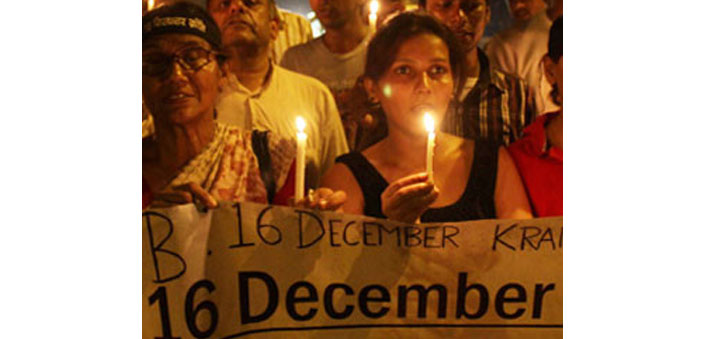How do we answer “How safe are we?” More important, can we? Are we equipped with the necessary laws and data to be able to claim safety in our country? Safety in terms of a nation has some necessarily tangible aspects to it, from road safety, safety from crimes like robbing/mugging, safety from conflict like situations within the nation, to safety in terms of sexual violence etc.
Let’s look at some statistics. India is ranked 141 on the Global Peace Index, 400 reported road deaths occur daily in India, and at least 34,651 cases of rape have been reported in 2015, according to data available with the National Crime Records Bureau (NCRB). It is startlingly becoming obvious that India is not safe, and that measures to improve safety are not working as fast as they should. Irrespective of whatever the increased reporting is credited to, be it to more awareness or government effort – the fact remains that a large volume of reports are still coming in, showcasing the lack in various aspects of safety in India.
Do we feel safe in our country?
How safe is India then as a country? How safe do our citizens feel? Do our citizens feel safe at all? To be able to answer these we need better data, more reporting, and more polls that look beyond standard safety measures, to also gauge perceptions of our citizens towards their own safety. How do we define safety here? Are we safe when all gendered persons can walk freely at any time of the day or night, without fear of sexual assault? Are we safe when driving is not made dangerous due to high incidents of accidents? Are we safe when our nation is free of internal conflict? Are we safe when we can travel in local trains without fear of theft? These questions are to serve as a thinking point, and to help us look at safety beyond traditional realms, and beyond these questions as well. Is safety the job of the government, or is it something that we as citizens need to demand? We do know for sure that India is not as safe as it could be, and that this impacts the quality of life of its citizens, as well as its economy and tourism industry. To build a better, stronger India, we need to make it safer!
Effects on tourism
“Women should use caution when travelling in India. Reported cases of sexual assault against women and young girls are increasing; recent sexual attacks against female visitors in tourist areas and cities show that foreign women are also at risk …”
– An excerpt from a UK travel advisory warning people about possible sexual assault as a major concern for women travelling to India.
A US State Department travel advisory to its citizens visiting India also highlights scamming of foreign tourists and sexual harassment, as being commonplace in India and for tourists to beware of such instances and their possibilities when visiting India – this advisory also led to a decrease in traffic of foreign travellers to India.
A quick online search on tourism and India will throw up at least a few articles on the first results page on unsafe experiences of foreign travellers in India. Delve deeper and you will see the virtual space populated by people speaking of their travel experiences in India, of having been scammed or faced sexual harassment. Travellers from outside India and even those from within India travelling to other places in our vast country, speak fondly of India, they reminisce of the beauty and majesty that is India, they speak of the hospitality of Indians, but they also speak of feeling unsafe at various points in their journey.
Cases of sexual assault against foreign tourists have also been on the rise. There have been cases of a Japanese woman being kidnapped and sexually assaulted near Bodh Gaya; of a Russian woman being assaulted in New Delhi, in 2015; of an Israeli woman being sexually assaulted by a group of men while she was travelling in Manali, in 2016. All of these cases find note in dossiers advising on Indian travel, and highlight safety concerns in India, impacting global perceptions of our nation. Any search on Indian travel will also give you a list of scams to avoid when one is in India. While scamming happens in most countries, it seems to happen a lot more in India. From being charged extra for goods and services, to scarier issues of being taken to lonelier locations and divested of one’s money – scams happening here range across the spectrum.
India is only the 38th most visited nation according the United Nations, the number of foreign tourists to India have also declined over the past decade or so, and this is despite India’s massive size, unparalleled beauty and the cheap travel options it offers; safety concerns definitely emerge as one of the reasons for this! Should we be concerned? Yes! Tourism is a major part of India’s soft power, and a way for it to showcase its culture to the world and weave itself into the international cultural dialogue. Tourism also adds a massive amount of money to our economy, creating jobs, supporting livelihoods and bringing in foreign exchange. Earlier, the National Council for Applied Economic Research estimates stated that tourism accounts for about 6.77% addition to India’s total Gross Domestic Product. Safety of tourists without accounting for any of these added benefits should anyway be a priority for a nation wanting to posture itself as a world power. Conflicts in certain regions of India has made governments of other nations advise their citizens against travelling to particular locations in India. The possibility of exploiting the tourism sector as a means to boost our economy becomes massive in the face of data showing the untapped potential of tourism in India. The opportunity tourism gives India to establish itself as a world power culturally, needs to be captured.
While safety has always been of concern, an interconnected virtual world with people sharing more of their personal experiences online and to a wider audience, increased reporting and media coverage, have shown an increase in the number of cases one hears of and in the number of incidents reported. While measuring in terms of data, cases of scams, sexual assault and other unsafe aspects may have gone up – what the country needs to focus on is getting rid of these unsafe factors in their entirety!
Building Brand India
This government, like previous governments, is also trying to address safety issues in the country, be it through way of setting up helplines and emergency phone numbers, increasing sensitivity training of its officers, or providing better, legislative support. In a push towards rebranding India and building Brand India on a world scale, the present government has also made efforts to boost tourism in India. What is still missing though is mass scale awareness, sensitisation and a better implemented legislative set up. There is a need to rewire the thinking of Indian citizens towards issues of corruption, gender equality, road safety, civic sense, and so on. What is reflected in statistics is nothing but the apathy of Indian citizenry towards any efforts to improve safety within the country.
We need to demand better laws and better implementation. We need to hold public servants accountable for lapses. We need programmes that educate, create awareness and sensitise citizens on these issues. It is the general attitude that also spills over to how we treat our tourists. Our nation needs an informed and engaged citizenry that is supported by more stringent laws, and an effective implementation system. A common unified helpline number for the country would help assist people in times of need, regular police patrolling that is meant to assist, than be part of moral policing, more official help desks at major tourist points, verification of various services online by the government to help check authenticity of businesses, could be some steps that could be taken to aid safety measures in the country.
The spirit of Atithi devo bhava (The guest is God) is definitely present in the spirit of our country, which is why, despite these issues, tourists continue to visit India. But we must strive to make our country safer for ourselves and tourists visiting our country, to help improve the quality of life overall.


 [/column]
[/column]